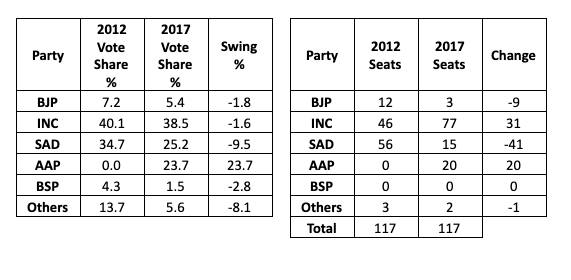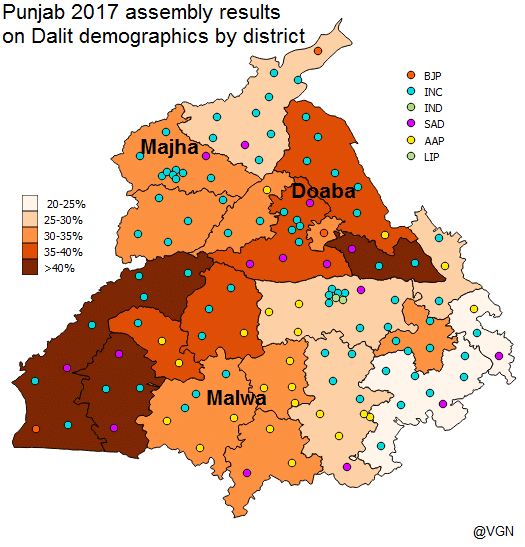Politics
Punjab 2022: Why SAD Jumped At Chance Of Tie-Up With BSP And What BJP Can Target Now That There's No Alliance Burden
Venu Gopal Narayanan
Jun 13, 2021, 02:00 PM | Updated 02:00 PM IST
Save & read from anywhere!
Bookmark stories for easy access on any device or the Swarajya app.


Politics in the Punjab has taken a sharp turn, with the Badal family’s Shiromani Akali Dal (SAD) and Mayawati’s Bahujan Samaj Party (BSP) announcing a formal alliance, six months ahead of assembly elections in the state. The BSP will contest only 20 seats, out of 117, leaving the balance 97 to the SAD. This forecloses any chance of the SAD coming back together with their former ally, the Bharatiya Janata Party (BJP), whom they left last year over the farm bills issue.
It is an interesting development, which makes the contest a genuine four-way split (between the SAD-BSP, the Congress, the Aam Aadmi Party (AAP), and the BJP). This is because Dalits form 32 per cent of the state’s population (the highest in the country), and, because Dalit voting patterns could have decisive, multiple ramifications on the fortunes of all parties in the fray, for pretty much the first time.
On the face of it, electoral arithmetic would have one say that the more splintered the Punjabi electorate, the easier the path for the Congress. But things are not so simple on the ground: a significant churning is underway in the state, with votes set to shift in bulk from one party to another, just as they did so dramatically in 2017, when the AAP made a magnificent entrance.
To recap the region’s politics briefly, the incumbent SAD was nearly wiped out in the 2017 elections, with almost a third of their vote going to the AAP. In fact, the AAP took 9.5 per cent of the vote share from the SAD, 8 per cent from ‘Others’, and bits from the rest, to tally a respectable 24 per cent. Amidst this mayhem, the BJP remained on the fringes in 2017, with 5 per cent of the votes, and three seats.
But, as the table below shows, the Congress lost only 1.5 per cent, which means that they were the only large party to blunt the AAP wave. That, allied with the hefty vote-splitting courtesy the AAP, is what gave the Congress a two-thirds majority with 38 per cent of the vote share.

What’s more interesting is that for a state with such a high Dalit population, the Punjab has remained largely untouched by a Bahujan wave, even though Kanshi Ram, the founder of the BSP, was born here.
The reason for this anachronism is socio-economic; although they comprise a third of the population, Dalits own hardly 2-3 per cent of the Punjab’s arable land. Further, the community is serially segmented into sub-castes, each with diverse, shifting, political loyalties.
This can get fairly confusing for run-of-the-mill commentators schooled in lazy, binary-driven, Occidental schools of identity classification, with Mazhabis, Chamars, Valmikis, Bazigars, Ramdassias, Ravidassias, and scores more, simultaneously identifying with multiple categories of faith, geography and caste within a loose Dalit ambit.
The net result is that the Dalit vote in the Punjab is about as divided as the Jat vote, the Sikh vote, or the Hindu vote there. So yes, the SAD and the BSP did have a brief alliance in the mid 1990s, and yes, there are indicators that the Chamar community holds a special preference for the BSP, on account of Kanshi Ram having been one of them.
But very little of such heavy theorising has traversed the gap to proof, or electoral results; case in point, the BSP has failed to pick up a single seat in the past two assembly elections, and its vote share in the state is currently down to about one per cent. Indeed, as things stand, the BSP’s popular appeal would aid the SAD in less than half a dozen seats.
It is the same with the AAP, whose twenty seats in 2017, analysts said, were wrested on the back of the Dalit vote. And yet, a map of those election results, overlain on Dalit demographics by district, show to the contrary that those AAP victories were actually restricted to south-central Punjab in the Malwa region; they didn’t win a single seat in those areas where the Dalit vote is more heavily concentrated – in the southwest, or the Majha region, and only two seats in the Doaba.

Consequently, trying to draw state-wide correlations between communities and voting preferences was an exercise in futility, until the SAD broke with the BJP over the farm bills. That rupture has finally brought into play the decisive importance of the Dalit vote, since the rest are split nineteen ways between the Congress, the SAD and the AAP.
The Congress is in a mess thanks to torrid internal dissent, and hence forced to fight itself, the epidemic, and anti-incumbency, all at once. At 38.5 per cent vote share, every per cent they drop further could mean the loss of half a dozen or more seats.
The SAD isn’t going to cut much ice with the so-called agrarian protesters, since Harsimrat Kaur Badal is on record, openly welcoming the original farm ordinance (which later became the bills and the acts) while she was a minister in the Modi cabinet. That means the SAD will be hard pressed to cast their net beyond their traditional vote base (ergo the tie-up with the BSP). At best, they may expect a return of some votes from the AAP.
In that case, the AAP may get squeezed. We got a hint of that in the 2019 general elections, when the AAP managed to retain only one of the four seats they won in 2014. And even in Sangrur, which Bhagwant Mann won with just 37 per cent of the popular vote, the party trailed in two segments.
That leaves the BJP. For decades, the party was content to play second fiddle to the Badals and the SAD. But the passing of the farm bills has changed things. Now, for the first time, marginal farmers in the Punjab can aspire with reason that in the future they will no longer be under the thrall of traders or intermediaries; and these sharecroppers are primarily Dalits.
This emancipation ties in with the BJP’s sustained, aggressive thrust of mainstreaming the Dalit community, at the national level, as an instrument to counter the caste prejudices which concretised during the colonial period. We saw it in Tamil Nadu during the recent assembly elections there; and we saw how a significant portion of the Trinamool Congress’s Dalit-Muslim axis, in West Bengal, was broken by the BJP. And lest we forget, Hans Raj Hans, who won from North West Delhi in 2019 with an astounding margin, is a Valmiki Dalit from the Punjab with a huge following there. So, from a civilizational perspective, the departure of the SAD has freed the BJP from the adverse excesses of political compromise.
No wonder then, that the bulk of the protesting farmers from the Punjab have been supported by those two parties most desperate to hold on to their vote bases – the Congress and the AAP. No wonder that the demographics of the protesters are so self-evident, with presence of Dalit farmers hardly being reported such congregations. And no wonder the SAD tied up with the BSP of all parties, so hastily, and so early in the day.
It would thus appear that the Punjabi Dalit vote may shift faster to the BJP than we presently realise.
How the BJP capitalises on this new, yawning electoral space which has opened up for it in the Punjab, remains to be seen, but it is a fecund furrow for the party to plough, and in line with its broader goals of raising electorates above identities.
All data from Election Commission of India website.
Venu Gopal Narayanan is an independent upstream petroleum consultant who focuses on energy, geopolitics, current affairs and electoral arithmetic. He tweets at @ideorogue.





